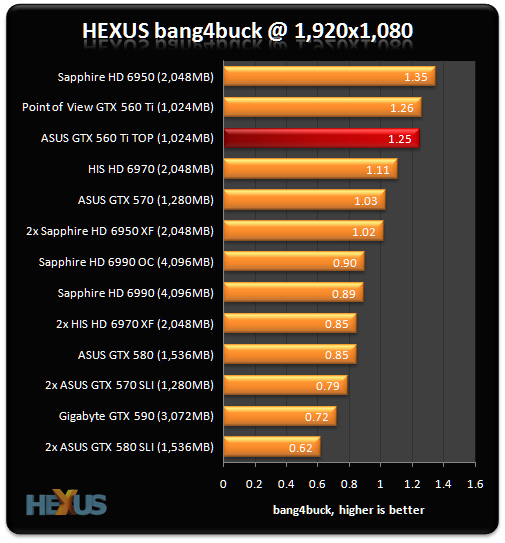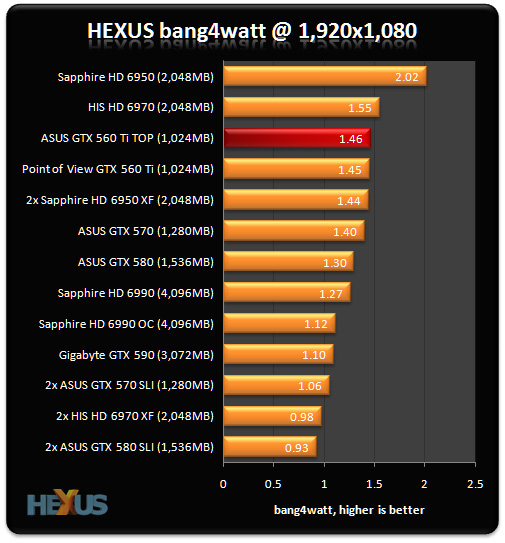HEXUS.bang4buck and bang4watt
Putting all the numbers into perspective, let's take a closer look at overall performance and value for money.
In a rough-and-ready assessment of the cards' bang for buck, we've aggregated the 1,920x1,080 frame-rates for six games, normalised them1 and taken account of today's pricing.
But there are more provisos than we'd care to shake a stick at. We could have chosen six different games, the cards' prices could have been derived from other sources and pricing tends to fluctuate daily, especially for new-release GPUs.
Consequently, the table below highlight a metric that should only be used as a yardstick for evaluating comparative performance with price factored in. Other architectural benefits are not covered, obviously.
Value analysis at 1,920x1,080 |
|||||||
|---|---|---|---|---|---|---|---|
| Graphics card | Aggregate FPS | Normalised FPS | Current price | Bang4buck1 | Power consumption2 | Bang4watt3 | |
| Gigabyte GeForce GTX 590 (3,072MB) | 538.4 | 433.5 | £575 | 0.72 | 393 | 1.10 | |
| 2x ASUS GeForce GTX 580 in SLI (3,072MB) | 620.4 | 486.9 | £780 | 0.62 | 524 | 0.93 | |
| 2x ASUS GeForce GTX 570 in SLI (2,560MB) | 553.5 | 443.4 | £560 | 0.79 | 419 | 1.06 | |
| ASUS GeForce GTX 580 (1,536MB) | 387.7 | 331.5 | £390 | 0.85 | 256 | 1.30 | |
| ASUS GeForce GTX 570 (1,280MB) | 337.0 | 287.1 | £280 | 1.03 | 205 | 1.40 | |
| ASUS GeForce GTX 560 Ti DirectCU II TOP (1,024MB) | 317.6 | 262.7 | £210 | 1.25 | 180 | 1.46 | |
| Point of View GeForce GTX 560 Ti (1,024MB) | 297.1 | 239.4 | £190 | 1.26 | 165 | 1.45 | |
| Sapphire Radeon HD 6990 OC (4,096MB) | 554.8 | 447.5 | £500 | 0.90 | 399 | 1.12 | |
| Sapphire Radeon HD 6990 (4,096MB) | 545.6 | 443.9 | £500 | 0.89 | 349 | 1.27 | |
| 2x HIS Radeon HD 6970 in CrossFire (4,096MB) | 568.4 | 458.0 | £540 | 0.85 | 465 | 0.98 | |
| 2x Sapphire Radeon HD 6950 in CrossFire (4,096MB) | 536.9 | 437.2 | £390 | 1.12 | 303 | 1.44 | |
| HIS Radeon HD 6970 (2,048MB) | 352.8 | 300.1 | £270 | 1.11 | 193 | 1.55 | |
| Sapphire Radeon HD 6950 (2,048MB) | 320.0 | 262.6 | £195 | 1.35 | 130 | 2.02 | |
1 the normalisation refers to taking playable frame rate into account. Should a card benchmark at over 60 frames per second in any one game, the extra fps count as half. Similarly, should a card benchmark lower, say at 40fps, we deduct half the difference from its average frame rate and the desired 60fps, giving it a HEXUS.bang4buck score of 30 marks. The minimum allowable frame rate is 20fps but that scores zero.
2 the GPU power consumption is derived from subtracting a flat rate of 100W - indicating system power-draw without a card - from the Call of Duty: Black Ops load figure. While this figure isn't solely indicative of power pulled by the GPU, as the CPU also throttles up, it's a better metric than using peak system-draw alone.
3 the HEXUS.bang4watt score is a crude measurement of how much normalised performance the GPU provides when evaluated against GPU power-draw that's shown in the table: the former is divided by the latter. We're using the peak power-draw numbers obtained by running real-world Just Cause 2.
Summary


NVIDIA's GeForce GTX 560 Ti really struggles to cope with ultra-high quality settings at 2,560x1,600, but at 1,920x1,080 it offers a generous amount of performance-per-pound.
Our bang4buck puts it fractionally behind a reference GTX 560 Ti, but this particular metric doesn't factor in some other key factors; temperatures, noise and overclockability.
But ASUS's card isn't only up against a myriad of rival GTX 560s, it's also challenging AMD's Radeon HD 6950 - and in that fight it falls fractionally short. Taking into account today's pricing, it's hard to ignore that a 2GB Sapphire Radeon HD 6950 offers very similar performance for £15 less.









